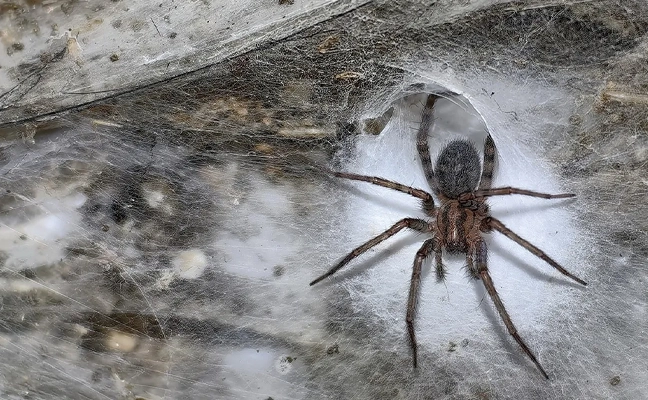Halloween is over, but spooky spiders are still around. Three new studies provide more insight into the world of arachnids.
Webs as vibrational alarm systems
The webs of many orb spider species (as opposed to funnel spider species) feature zigzag, hub-and-spoke patterns known as stabilimenta. While previously thought to serve roles like temperature regulation or water collection, a study suggests these silk structures function as finely tuned sensory instruments. New research from the Swedish University of Agricultural Sciences indicates that the stabilimenta “may boost a spider’s ability to pinpoint the location of prey caught in its web,” per an Eureka Alert news release.
The geometry of these decorations is key to their functionality. The authors point out, “This study reveals that the decorative stabilimentum in [European wasp spider, or] Argiope bruennichi webs is more than just ornament, for it subtly changes how certain vibrations travel through the web.”
As an online news story on the study from IFLScience quips, “It could be that these decorations are akin to installing a few extra doorbells so you don’t miss the takeout delivery driver.”
Fishing with fireflies
IFLScience also reports on a study from Taiwan’s Tunghai University, recently published in the Journal of Animal Ecology. Researchers found the sheetweb spider (Psechrus clavis) catches male winter fireflies (Diaphanes lampyroides) and leaves them in their webs for up to an hour. As the fireflies continue to signal with their bioluminescence, the signal attracts up to 10 times more prey vs. webs without the glow. Unlike other firefly species whose glow “blinks,” the winter firefly has a steady light. Similarly, sheetweb spiders resemble their common name — their webs are neither orb- nor funnel-shaped.
There’s a name for this kind of “species hijacking”: sensory exploitation. “This study sheds new light on the ways that nocturnal sit-and-wait predators can rise to the challenges of attracting prey,” lead author Dr. I-Min Tso says in the article.
A Science Daily news story explains how the experiment worked – with no fireflies harmed:
They placed LEDs that resembled fireflies in real sheet spider webs and left other webs clear as controls.
They found that three times the amount of prey was attracted to webs with the LEDs compared to the control webs. This increased to 10 times more prey when they only looked at fireflies being captured.
The findings confirm that captured fireflies left as bait increase the hunting success rate of the spiders. The researchers also noticed that the majority of captured fireflies were male, who were likely mistaking the glow for potential mates.
See video of a spider fishing expedition in action below:
Silk City, here we come
While you may have battled some big webs in the field, the world’s biggest spiderweb is considered to be the recent discovery of a 1,140-square-foot structure found deep inside Sulfur Cave on the Albanian-Greek border. The colony consists of a patchwork of thousands of individual, funnel-shaped webs and houses more than 111,000 spiders thriving in a permanently dark zone.
The colony is composed of two species: the barn funnel weaver (Tegenaria domestica) and the sheetweb-spinning vagrant spider (Prinerigone vagans). Both species are typically solitary, and per a news article from Live Science, the vast numbers in this cavern are the first evidence of colonial behavior in them. The study was published by Subterranean Biology by researchers from the Sapientia Hungarian University of Transylvania in Romania.

The cave is hollowed out by natural springs rich with sulfur, which provides an unusual food chain: the spiders prey on non-biting midges, which in turn feed on microbial biofilms from sulfur-oxidizing bacteria. This sulfur-rich diet is so influential that the spiders are genetically different from their relatives outside.
It seems the more we learn about spiders, the more we realize we don’t know. It should be interesting to see what these findings could lead to in the professional pest management industry. Maybe we’ll create sticky trap monitors for flying insects that mimic spider webs with intricate designs, LED lights and a light sulfur scent!
Leave A Comment